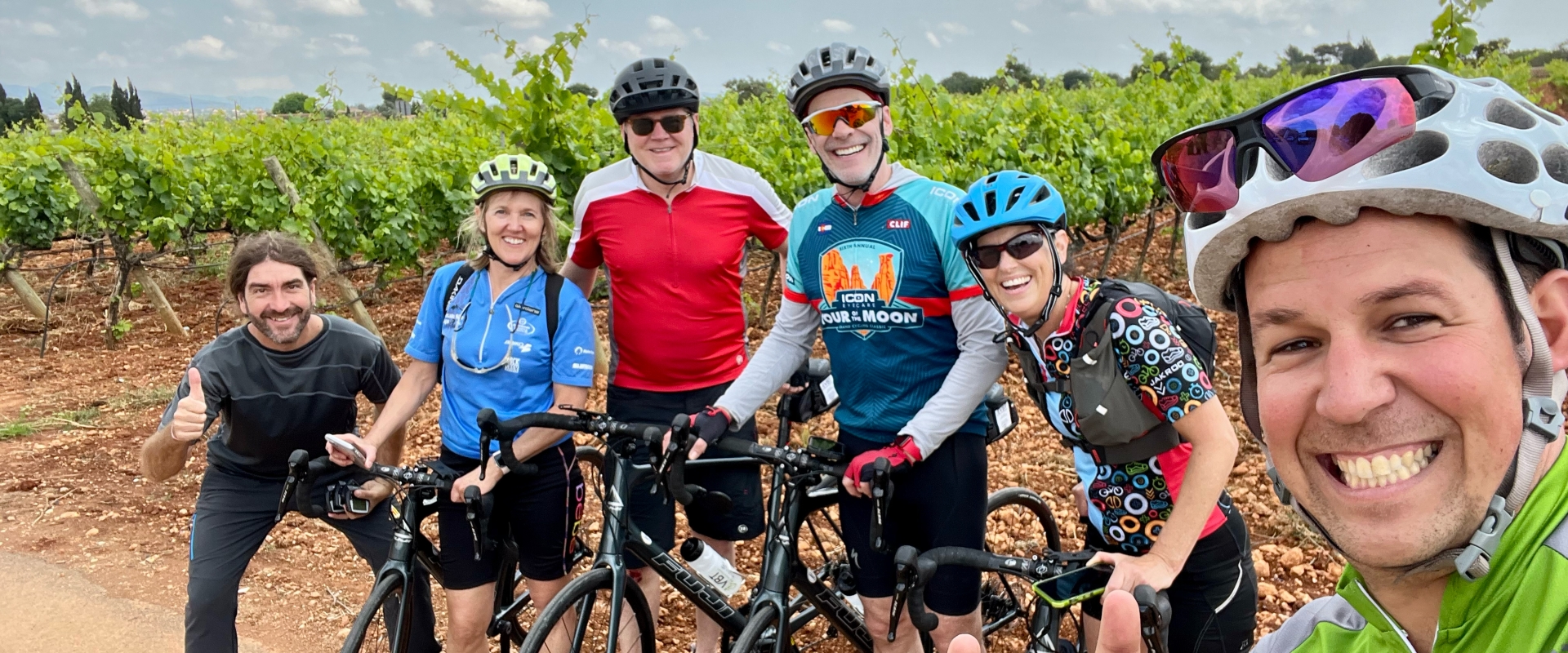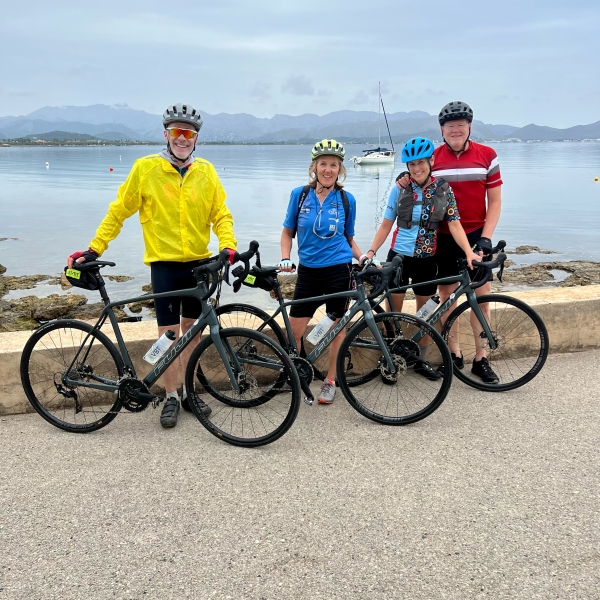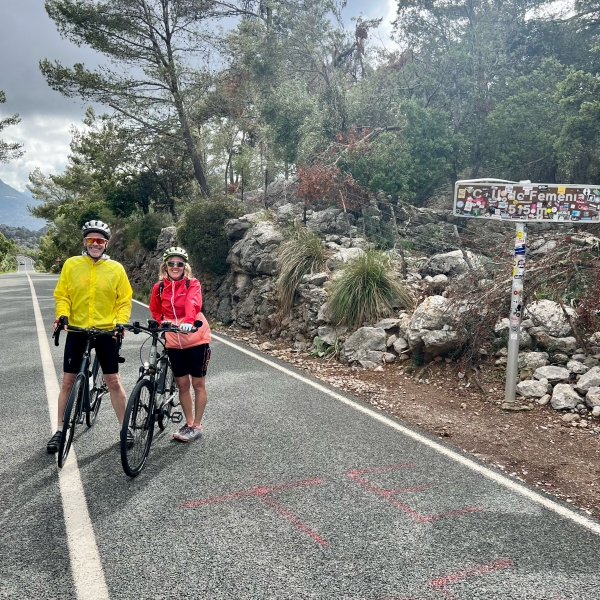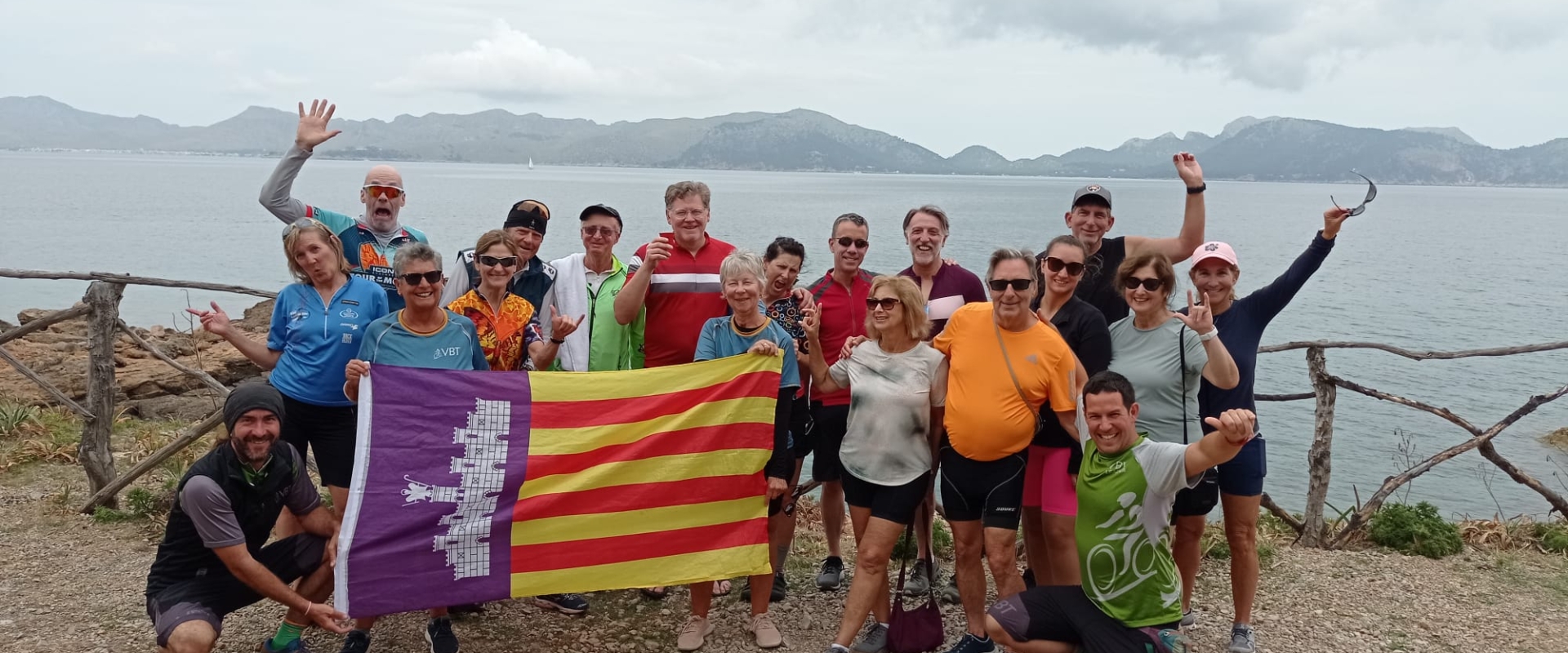Note: This account was written by VBT guest John Tedstrom. He is a long-term student of life and freelance writer, celebrating many adventures that include growing up in Australia and Brazil, traveling to more than 35 countries, and visiting 48 US states. Currently living near Vail, Colorado, John is an avid cyclist on road and mountain, an alpine and cross-country skier and instructor, and very active in all forms of skiing, white-water stand-up-paddle-boarding, and hiking. Most of all, John loves time spent with family and friends, especially his 2-year-old grandson, Milo.
Spain
There’s More to Mallorca Than Meets the Eye
Posted on Monday, March 25th, 2024
Story by: John Tedstrom | Travel Writer

The View of Mallorca from a Bicycle Seat
I’m shivering, soaked, and need windshield wipers on my sunglasses. Wishing I could throw my bike in the van for a ride back down the steep road to somewhere that serves beer. Caught in a sudden rainstorm on the first “independent” ride of our 6-day tour with VBT in Mallorca, we were near the top of the famous Coll de Femenia outside of the ancient Roman town of Pollença. What started as a cloudy ride to the Lluc monastery on a steep road quickly became more interesting. Independent means “on our own,” so hopes of a pickup were slim to none. Pedaling to stay warm, I wondered what we’d find at the monastery—a crumbling ruin with beggars outside, or a working monastery with a restaurant serving hot food and Mallorcan beer?
A lot has been written about the joys of a trip to Mallorca, but not as many from the point of view of a bicycle seat. As a lifelong cyclist, I want to share the pleasures of seeing Mallorca by bike. Before our trip, I barely knew where Mallorca was, and nothing about its history, charm, and beauty. I’ve done a 6-month solo bicycle tour across Europe, ridden Cape Cod, cycled in Tasmania and I ride several times a week—road bikes or mountain. But my rides are self- supported, meaning you’re on your own and carry your own gear. In Mallorca, our guides Joan (pronounced Yoe-Ahn) and Juantxo (pronounced Hqwuan-Cho) from VBT made it easy so anyone can do it. They supported us with a van, took care of our bikes, hosted our events, and made sure we were all set in our beautiful 4- and 5- star hotels. On rides, they’d surprise us when we rounded a corner to find snacks and lemonade right when we needed them. One day we rode past Joan’s house, and he serenaded us with his classical guitar. My wife Carri and I have decided we’ll never do another self-supported trip.
Not only did we have great support, but we saw things you’d never see on other trips. Because on a bike, you’re in it, not just driving past it, or staying in a single resort. We had the best of both worlds, staying in beautiful hotels at night and being immersed in the countryside around Palma, the mountains near Sóller and Pollença, the coast around Alcúdia and Cap de Formentor in the north, and the nature park and salt flats in the south of the island. So, if you’re reasonably active and like being on bikes, or if you’re really into biking, a bike tour like this may be in your future.
You can see our day to day itinerary on the VBT site if you follow the link to the Spain: Balearic Islands, Mallorca & Ses Salines Guided Tour. The route was so well planned that we were on tiny country roads for most of it, and supported so our rides were just the right distance to enjoy the biking but not too hardcore. We stayed two nights each in three unique regions of the island—including the charming town of Sóller surrounded by orange groves, the historic seaside city of Pollença to the north, and along the southern coast near the famous Es Trenc beach. We even had an impromptu jam session on the piano in the hotel’s restaurant, singing The Letter, Your Song, and Reelin’ in the Years before the staff asked us to tone it down.
Each year, Mallorca hosts nearly 35,000 cyclists, from casual riders to international cycling teams, and everyone in between. The terrain is as varied as the cyclists. You can take an advanced tour and follow hardcore routes, like “Big Daddy” in the Tramuntana mountains. Or you can take an easy/moderate trip like ours, which means mostly flat with rolling hills, and a couple of harder “independent rides,” thus leaving more time for Mallorcan food, wine, pastries, and beer. The views on every ride are fantastic—from cobblestoned villages festooned in hanging flowers to lighthouses on rocky cliffs over crystal blue water. Due to an endemic aquatic plant called Oceanic Posidonia, Mallorca has the brightest blue water I’ve ever seen. On one of our rides from Pollença to Alcúdia, we got to swim in that blue Mediterranean and enjoy a picnic on the beach for lunch.
Mallorca, the largest of the Balearic Islands of Spain, historically of great strategic value in the center of the Mediterranean, is now a major European tourist destination that you really need to see for yourself. Since the first settlements of Tayalotic people from Bronze and Copper Ages, Mallorca has been conquered by Romans, Moors, Christian knights from Catalonia, Spain, and used as a feared base for pirates. You can see this history in most buildings in a layer cake of Roman foundations at street level, Moorish walls, and windows above, and 12th-century Christian architecture on top. “Balearic” means “stone slingers”, as the men of the island were known as fearsome warriors throughout the Mediterranean. When the Romans first tried to conquer the island, the stone slingers blew holes in their boats with their accurately placed stones. When the Romans returned, they covered their boats below the waterline in leather.
Coll de Femenia was one of the independent rides, and just four of us rode that day. When the rain started to fall, we were surprised to see Juantxo show up in the van, because this was an independent ride, and he was on his time off. But when torrential rain fell in the town below, he got worried and jumped in the van to see if we needed help. He brought energy bars and even loaned his own rain jacket to my friend Dave, who didn’t bring one. When we said we intended to ride to the top, he told us he’d meet us there. So, on the road when wet, cold, and tired, I looked to my right and saw Juantxo, cheering me on from the van. When we made it to the top we found, not a ruin, but a cozy restaurant serving wine, beer, and hot crusty pizza! Juantxo even found two towels in the van so I could dry off. After beer, most of a whole pizza, and drying my gloves and jacket in the hand dryer in the bathroom, I was good to go right when the rain stopped. The sun came out and the ride down was dry, and glorious, seeing the views we couldn’t see on the way up. So worth it!
The rest of our rides were a joy; narrow winding roads with “dry stone” walls on both sides draped by cascading violet and magenta bougainvillea, and streets lined with blossoming jacaranda, fragrant hibiscus and oleander, past fields of almond, olive, carob, and citrus. In between was an adventure of Mallorcan food and wine, fresh bread, and olive oil, ensaïmada pastry, hierbas aperitif cocktails, Mediterranean views, and two thousand years of history. As you might expect, VBT had something for everyone; five of us were on road bikes, two rode hybrids, and 10 on E-bikes. Our road bikes were new Fuji 1.3s, carbon frame, disc brakes, and comfortable geometry perfect for this tour. We brought our own shoes and pedals so we could clip in. Through 6 days of biking, usually with a morning and afternoon ride, and two of the independent rides, every day we were surprised by a different highlight.
Highlights started the first day. At a winery after our first warm up ride, we were greeted by Kike Marti, an international paella chef, teaching a paella lesson using special rice he grows on his own farm. Kike was a great host, and the paella was a treat. We toasted with local wines and finished with more ensaïmadas. Next day, after riding to Sóller, we had lunch at Can Det, a 16th-century manor house that’s been producing olive oil for 500 years, from 1,000 year old trees, by the same family! Our host, Tomeu Deya, current patriarch, started the tour pulling water from a stone chute across the street. He told us how fully ripened olives are handpicked from remote trees. We saw the oil crushed from the olives using an ancient stone press of two spherical cones; only modernized by swapping out donkeys for a gas-powered engine. Then stuffed into woven circular bags that are placed on an olive press to squeeze out the juice for additional filtering. After the tour, we had a tasty lunch of fresh olives, Pa amb oli (a traditional Mallorca dish of fresh crusty bread, olive oil, and local tomatoes rubbed into the bread), prosciutto, black and green olives, and red wine, while sitting beneath a family tree showing 75 generations of their family who’ve run the house for five centuries. Tomeu’s granddaughter handles the social media for them today.
VBT served up many surprises. Next up was the Oliver Moragues Grandhouse & Vineyard on our ride from Pollença to our last hotel. It’s a small inn in a traditional manor house, on a Mallorcan finca, surrounded by vineyards. The winery brings to life Mallorcan tradition and history that you can see in the uneven cobblestone entry where horse and cart brought food directly into the house, and the cold storage room in the cellar surrounded by ancient handmade glass containers villagers used to collect their wine. Since 1511, the same two families have owned the estate, dedicated to making wine here for more than 500 years. We were told that when the Spanish conquered the island and built the house in 1229, the history of the property goes back even more. Meeting the current generation, we learned their goal to make wine here for another 500 years. But they said it’s tough when they receive offers to buy the property every day, amidst daily struggles to make enough money to support it. Hotel guests stay in the ancient house or newer guesthouses, enjoy two pools and a fresh vegetable garden full of exotic Mallorcan veggies. We loved the OM wines and had one of the best meals of the trip—a typical lunch of Mallorcan tapas accompanied by four wines for tasting: Mallorcan tortilla, coca de trampó (Mallorcan pizza), Mallorcan empanada, pa amb sobrasada, salad, and sugar shellac’d cremadillos for dessert.
Our favorite towns were the mountainside village of Fornalutx and Port Sóller. Fornalutx is a tiny village high in the Tramuntana mountains, said to be the “prettiest village in Spain.” The ride to Fornalutx was our favorite ride too, through orange and lemon groves and up a few hills to classic Spanish stone buildings, red tiled roofs and narrow streets overflowing bougainvillea, oleander, and hibiscus that pull you in with a traditional rustic charm. Port Sóller, another beauty, sits on a horseshoe bay with a wide boardwalk with an old lighthouse on the head, surrounded by many bars and restaurants, where we had cocktails.
As a prequel to the ride, we spent two advance days in the capital city of Palma. We discovered late night snacks of grilled sandwiches with salmon and local honey at Café L’Antiquari, a quirky hole in the wall near our hotel. We toured the city, dominated by the 12th-century Cathedral of Santa Maria del Fiore, which has the largest rose window in the world and interior redesigned by Gaudi, and the Royal Palace of La Almudaina, which dates to the 14th-century, and is the official residence of the King and Queen during their stays in Mallorca. Food was a big part of the unexpected joy of Mallorca. Our evening started with Aperol spritzes and Negronis at the rooftop bar at the El Llorenç Parc de la Mar hotel with a sweeping view of the Bay of Palma plus dinner at La Vieja Gastronomia by Jonay Hernández, where more Negronis and the Iberian pork bichillo were hits. We stopped at Claudio’s for award winning hazelnut gelato on the way back to our hotel.
The highlight of the pre-trip was a Withlocals tour called The Ten Tastings of Mallorca. Billy, our guide, walked us around Santa Catalina and shared the secrets of Mallorcan treats like the red sausage sobrasada on crunchy toasts, tortillas de patatas, Gilda anchovies on toothpicks with hot peppers in garlic, vinegar and olive oil, tuna empanadas, and Mallorcan bread. We stopped in places we’d never have approached on our own, including the bakery Forn de la Glòria where we were served sobrasada toasts by the baker with a tiny baby on her hip, and even stopped at a Vermuteria for vermouth on tap. Finished off with ensaïmada pastry and gelato at Ca’n Joan de s’Aigo so we were prepared for all the flavors to come.
All in all, touring Mallorca from a bicycle seat is a great ride.



 VBT Bicycling Vacations
VBT Bicycling Vacations Country Walkers
Country Walkers